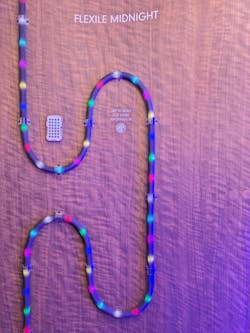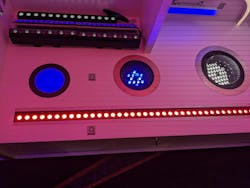A bustling crowd descended upon the ballrooms and meeting rooms at the New York Hilton Midtown last week for the 18th year of LEDucation. The Designers Lighting Forum New York (DLFNY) reported a record-high 470 exhibitors and revealed that more than 375 exhibitors have reserved booth space for 2025. More than 10,000 registrants filled conference sessions and walked the tradeshow floor to discuss industry trends and products. The growth of this event has been impressive; however, I would note that the space was a bit more difficult to navigate with the increased attendance. It’s not a bad “problem” to have if you are organizing a show!
What stood out to me as I walked the floor – even more than the variety of products from names both familiar and new to me – was the sense of camaraderie and enthusiasm to meet in person that has grown since remote work has become normalized and travel has become more selective for some of us post-pandemic. Although of course I had conversations about products on display, it was most enlightening to me to learn about the ways in which exhibitors were navigating their business, incorporating sustainability initiatives into both their product designs and their operations, and carefully considering product additions to address pinpointed customer needs rather than drop an abundance of SKUs. Many of those demands represented ease of use and adjustability, unobtrusive products that merge into architectural materials, and the ability to deliver high-quality, comfortable illumination in the right place.
Early on, I visited the Saliot Lighting (a subsidiary of MinebeaMitsumi Group) display to discover its motorized lighting offerings. Senior account manager Kevin King demonstrated the smooth response of the Smart Adjustable Light for the Internet of Things (SALIOT) through the company’s smartphone app and an external infrared tracking accessory. High-ceiling applications in multipurpose gathering areas such as function halls, ballrooms, and large exhibit spaces pose a challenge for operators, King said, where they may want to have illumination following a speaker or place a spotlight on individual tables or displays that will be frequently reconfigured. Manual adjustments are time consuming and labor intensive, so the SALIOT beam distribution angle, dimming/intensity, and pan/tilt can be adjusted through the app or can even be easily set up to follow an event speaker with the wearable IR tracking device and remote. Nichia LEDs deliver about 95 CRI, King noted. Key points: Flexibility of use, light quality.
When asked about sustainability efforts at the LumenTruss booth, Anthony Daher, vice president of sales and marketing, drew my attention to the latest linear poplar fixtures. The wood is sustainably sourced from North American forests certified by the Sustainable Forestry Initiative, Daher said, and the company continues to support carbon reduction objectives by planting a tree for every wood profile sold. The minimalist profiles of the linear fixtures house an aluminum heat sink, and can be configured for direct or indirect illumination with various lens options. Different models will deliver 90+ or 95+ CRI depending on the lumen package. Key points: Sustainability, materials.
Kenall product development manager Nate Heiking provided a new angle on the company’s established utilitarian lighting for institutional, healthcare, and high-abuse commercial environments. While the Legrand company’s sales of Indigo-Clean visible-light disinfection luminaires are still growing and mainly incorporated into critical healthcare environments such as operating rooms, Heiking explained, Kenall is also penetrating some school use cases, such as locker room facilities. But more telling is the brand’s push toward answering aesthetic needs alongside technical demands such as well-sealed cleanable surfaces and tamper resistance. Heiking pointed out circular and wall-mount luminaires with improved style along with clean, rounded edges for ligature prevention, and the tunable offerings that are designed to deliver more comfortable ambient illumination alongside circadian support for medical, behavioral health, and correctional environments. Key points: Light quality, safety.
Tivoli Lighting vice president Larry Lin noted that all of the company’s high-efficiency tapelights now have Declare labels for materials transparency. Some of the most interesting features on display included turtle-safe amber light options for outdoor architectural, façade, and decorative illumination, and the Flexile bendable light engine that can be mounted or draped into luminaire form factors or installed as flexible architectural linear lighting. The Flexile Midnight was an additional fun component, with its interactive capabilities enabled via DMX control – the black jacket makes colors pop. Key points: Sustainability, flexibility.
At the Acclaim Lighting booth, Mark Etcovitch, president of Canadian distributor Rite Lites, showed the in-ground Terra Drum and Linear models that “a firetruck can drive over,” given the fixtures’ ability to withstand more than 6,000 lb of drive-over weight. The newer circular Terra Drum offers a wide range of selectable white CCTs and color options as well as beam angles. With the Terra-Tilt gimbal feature, the beam angle can be adjusted with the fixture in place – without disrupting the factory seal. The precise beam control, tamper resistance, robust coating and hardware, and DMX RDM controllability were impressive features. Key points: Flexibility of use, hardiness.
Finally, on the component side, Cree LED Americas vice president of sales Tony Grieco gave our team a rundown on the new 2835 Pro9 LED package technology while publisher Janice Oliva was able to sample the tunable CCT and dimming at the booth test station. I asked Grieco if the LEDs on display utilized the red phosphor technology licensed from Current Lighting, and he confirmed that they did, contributing to an efficacy improvement for 90 CRI LEDs. Grieco mentioned the LED developer’s focus on application-specific light quality and efficacy to balance price and longevity for applications such as indoor lighting, where these LEDs would serve. The Precision Dimming appeared smooth and consistent alongside the transitions in tunable white CCT. Key points: Light quality, color precision, and dimming performance.
In general, the mood was positive and attendees and exhibitors with whom we spoke were confident in the growth opportunities within the lighting market. Many also noted the steps manufacturers are taking toward reducing carbon footprint and managing environmental considerations with their product designs and sourcing. As I’ve mentioned before, I’m particularly interested in how those efforts shape the lighting business; and I believe environmental stewardship will be one of the biggest drivers of innovation and distinction in the market.
CARRIE MEADOWS is editor-in-chief of LEDs Magazine, with 20-plus years’ experience in business-to-business publishing across technology markets including solid-state technology manufacturing, fiberoptic communications, machine vision, lasers and photonics, and LEDs and lighting.
Follow our LinkedIn page for our latest news updates, contributed articles, and commentary, and our Facebook page for events announcements and more. You can also find us on the X platform.








